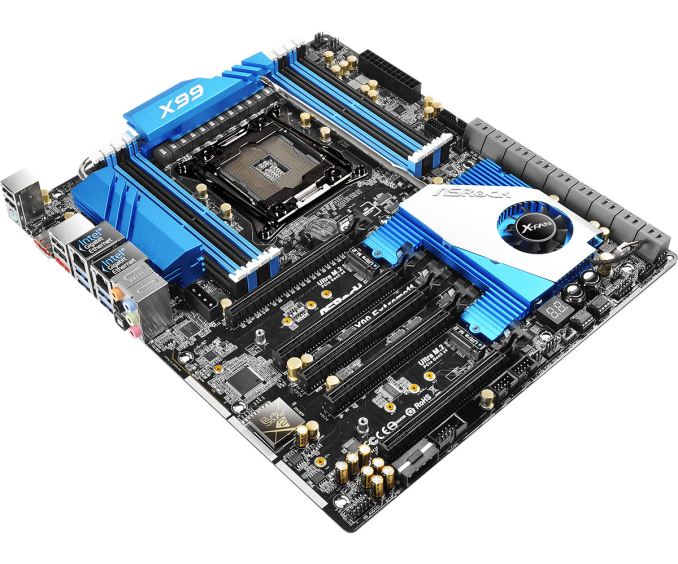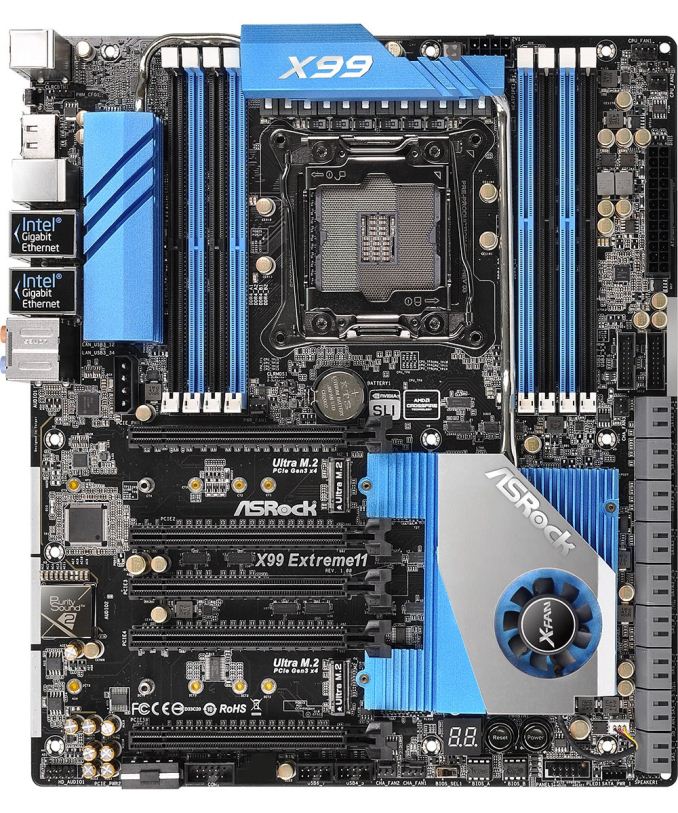ASRock Releases X99 Extreme11: So I Heard You Like Storage
by Ian Cutress on October 9, 2014 7:30 AM EST- Posted in
- Motherboards
- Intel
- ASRock
- LSI
- X99
 (2)_678x452.jpg)
We reviewed the X79 Extreme11 back in September 2012. The concept was simple: divert eight PCIe lanes into an LSI SAS chip for eight more SATA ports with SAS compatibility. Then ASRock released the Z87 Extreme11 which combined the LSI chip with a port multiplier, upping the total from 8+6 to 16+6. The X79 required two PLX8747 chips to also enable x16/x16/x16/x16 + LSI, whereas the Z87 only used one PLX8747 for x8/x8/x8/x8 + LSI.
Now insert the X99 version of the Extreme11. It gets a bit tricky here, because SATA is not the only storage around. Add into the mix that the chipset supports 10 SATA ports on its own then there is the potential for something silly, or awesome, or perhaps a little of both. The X99 Extreme11 uses the same LSI SAS 3008 without the port multiplier, but add in the 10 chipset ports X99 already provides and it gives a total of 18. This LSI chip uses eight PCIe 3.0 lanes and supports RAID 0/1 only, but still allows ASRock to publish 6.1 GBps peak read/write when top end SATA drives are connected to each port.
The X99 Extreme11, similar to the Z87, uses two PLX chips to achieve x16/x16/x16/x16 support along with the LSI chip. To throw some more into the mix, the motherboard also has two Ultra M.2 slots, with both supporting PCIe 3.0 x4 connectivity and 22x110 sized drives. These M.2 x4 slots are still good for 2.8 GBps according to ASRock, and while they won’t be RAID capable in hardware, a software layer might provide an interesting project.
The motherboard will support Xeons with either UDIMMs or RDIMMs, along with ECC support. Networking is provided by two Intel NICs, the I218-V and I211-AT, with support for Teaming. The PCIe slots will support x16/x16/x16/x16 even with the 28-lane i7-5820K, although using that CPU will disable the second M.2 x4 due to the lack of bandwidth.
ASRock is keen to promote their 12-phase power design, which we see paired with large heatsinks. A heatpipe connects all three heatsinks, with the heatsink on the left there only to provide extra surface area. The chipset heatsink is also dealing with the LSI controller, hence the size and the active cooling. Users in the past often express concern about small fans like this, although it can be disconnected if the user has their own sufficient cooling.
The board has eight USB 3.0 ports, six from the chipset and two from an ASMedia controller powering two of the rear IO ports. Also onboard is a COM header, seven fan headers (only two are 4-pin), Realtek ALC1150 audio in Purity Sound 2 and a dual BIOS topology. Because of the use of 4-way PCIe, there are two connectors on board for additional VGA power, although these are molex connectors which I disapprove of. One of them is to the left of the middle of the board, making cable management a nightmare.
The Rear IO has two eSATA ports, both of which are shared with specific SATA ports on the motherboard, meaning only one can work at one time. The back panel also has a PS/2 combination connector, four USB 2.0 ports, four USB 3.0 ports, the two Intel network ports and audio.
In ASRock’s YouTube video promoting the motherboard, they paired the system with an 18-core E5-2699 v3, 128GB of DRAM, four GTX 780 Ti cards, two M.2 x4 drives and 18 SSDs. See you later, I need to sell a kidney and perhaps a lung as well.
I would not be surprised if the X99 Extreme11 ends up being the most expensive X99 motherboard on the market. The two PLX 8747 chips, as well as the LSI 3008, are not cheap for the end-user. Though if a user wants to wire up a large Xeon, a ton of memory, four GPUs, a dozen or more storage devices or any combination therein, then the price of the motherboard might be quite low down on the list. The X79 Extreme11 retailed for $600, so I suspect that this motherboard will be in the same ballpark.
I have requested a review sample, and hopefully we can delve into the interesting PCIe arrangement under the hood. It will be interesting to see how everything is wired up. A full specification list can be found on ASRock's X99 Extreme11 page.







_thumb.jpg)


 (2)_thumb.jpg)








40 Comments
View All Comments
ZeDestructor - Thursday, October 9, 2014 - link
So does the Asus X99-E WS. They added the ECC QVL a short while ago :)Kougar - Thursday, October 9, 2014 - link
I'm really confused, why are the PCIe 3.0 x4 connected M.2 slots only rated for ~350MB when the interface is capable of almost 4GB/s? My understanding was the M.2 interface maxed out at 1.2GB/s.extide - Thursday, October 9, 2014 - link
I am thinking 2.8GB a sec is 2.8Gbytes a sec not Gbit a sec. Otherwise, yeah, it wouldn't make sense.M.2 isn't really an interface, it's a connector, so it's b/w is entirely dependant on the actual interface used under the hood, and it supports many different configurations.
Kougar - Thursday, October 9, 2014 - link
Okay, that would make much more sense. So does the board support NVMe on M.2, I assume it would since it's an actual PCIe connection?erikb5 - Friday, October 10, 2014 - link
Because each M.2 is associated with a single SATA3 port.Look at the Manual on Page 27.
"If the Ultra M.2 Socket (M2_1) has been occupied, the internal S_SATA3_2 will not function. If the Ultra M.2 Socket (M2_2) has been occupied, the internal S_SATA3_0 will not function."
Page 46
"Please be noted that the M2_1 is shared with the S_SATA3_2 connector, and the S_SATA3_0 connector is shared with the M2_2.
* If you install CPU with 28 lanes, the PCIE function of M2_2 will be disabled."
erikb5 - Friday, October 10, 2014 - link
Extra reading on the PLX PEX8747 the plxtech dot com page.http://www.plxtech.com/products/expresslane/pex874...
The two PLX PEX8747 switches transform two x16 flows into a single x16 flow.
So a 4 SLI config is a Switched x16/x16 + Switched x16/x16 and + 8 PCIe lanes for storage + audio.
Omoronovo - Tuesday, October 14, 2014 - link
Hi,When running in Sata mode with sata-based m.2 SSD's, the ports act like slower sata 3 ports; hence 350MB/s. The slower throughput is due to the unfortunate way they have configured the sata lanes on m.2 slots, but in my opinion this is excusable as they have obviously focused the M.2 ports to be used with PCIE-based drives.
As seen from the video, with both M.2 ports fitted with pcie-based SSD's (XPI941's from Samsung), they aggregate 2.8GB/s (GB, not Gb) of bandwidth. They benchmark a hodgepodge of SSD's from the 18 sata ports which manages 7.8GB/s.
danjw - Thursday, October 9, 2014 - link
I guess if you only have 1 system for both workstation and file server it might work for you. Otherwise, I think I would prefer the Asus Z10PAD8 for a file server. It support the LSI PIKE II cards and comes in $200 less and is a close to a standard ATX form factor with only 10" of depth. So, it should fit in a much wider range of cases.dgingeri - Thursday, October 9, 2014 - link
If someone wanted to build a VM host for their own personal training using cheap drives left over from numerous upgrades over the years, this would be a good board for it. It would have the slots for plenty of network I/O, even 10Gb. The storage controllers built into it would be good for plenty of drives. The memory capacity and processor could host many small VMs. On top of all that, it could double as a gaming machine with a couple GPUs.traest - Thursday, October 9, 2014 - link
What kind of a case would you put a motherboard like this in (that would handle 18 hard drives)?